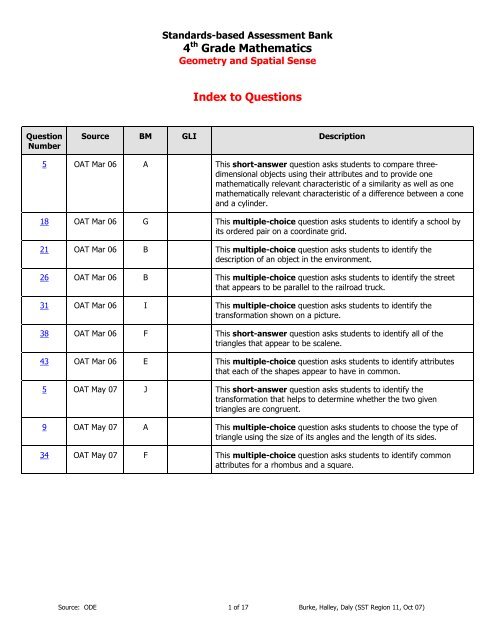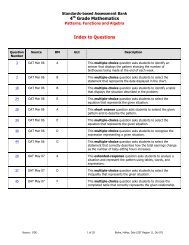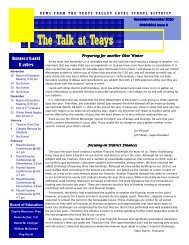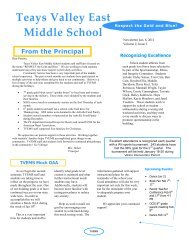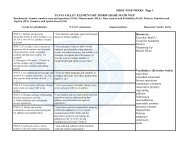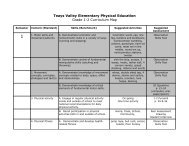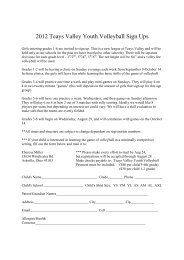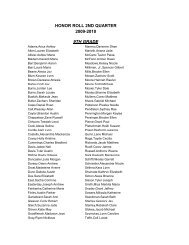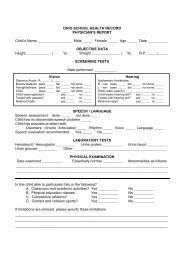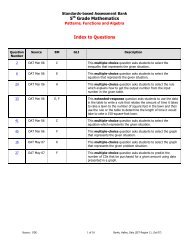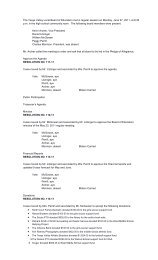Geometry & Spatial Sense
Geometry & Spatial Sense
Geometry & Spatial Sense
Create successful ePaper yourself
Turn your PDF publications into a flip-book with our unique Google optimized e-Paper software.
Standards-based Assessment Bank<br />
4 th Grade Mathematics<br />
<strong>Geometry</strong> and <strong>Spatial</strong> <strong>Sense</strong><br />
Index to Questions<br />
Question<br />
Number<br />
Source BM GLI Description<br />
5 OAT Mar 06 A This short-answer question asks students to compare threedimensional<br />
objects using their attributes and to provide one<br />
mathematically relevant characteristic of a similarity as well as one<br />
mathematically relevant characteristic of a difference between a cone<br />
and a cylinder.<br />
18 OAT Mar 06 G This multiple-choice question asks students to identify a school by<br />
its ordered pair on a coordinate grid.<br />
21 OAT Mar 06 B This multiple-choice question asks students to identify the<br />
description of an object in the environment.<br />
26 OAT Mar 06 B This multiple-choice question asks students to identify the street<br />
that appears to be parallel to the railroad truck.<br />
31 OAT Mar 06 I This multiple-choice question asks students to identify the<br />
transformation shown on a picture.<br />
38 OAT Mar 06 F This short-answer question asks students to identify all of the<br />
triangles that appear to be scalene.<br />
43 OAT Mar 06 E This multiple-choice question asks students to identify attributes<br />
that each of the shapes appear to have in common.<br />
5 OAT May 07 J This short-answer question asks students to identify the<br />
transformation that helps to determine whether the two given<br />
triangles are congruent.<br />
9 OAT May 07 A This multiple-choice question asks students to choose the type of<br />
triangle using the size of its angles and the length of its sides.<br />
34 OAT May 07 F This multiple-choice question asks students to identify common<br />
attributes for a rhombus and a square.<br />
Source: ODE 1 of 17 Burke, Halley, Daly (SST Region 11, Oct 07)
Standards-based Assessment Bank<br />
4 th Grade Mathematics<br />
<strong>Geometry</strong> and <strong>Spatial</strong> <strong>Sense</strong><br />
Benchmark:<br />
A<br />
Provide rationale for groupings and comparisons of two-dimensional figures and<br />
three-dimensional objects.<br />
GLI:<br />
Short Answer Question:<br />
5. A cone and a cylinder are shown.<br />
Commentary:<br />
This short-answer question asks students to compare three-dimensional objects using their<br />
attributes and to provide one mathematically relevant characteristic of a similarity as well as one<br />
mathematically relevant characteristic of a difference between a cone and a cylinder.<br />
A response earning the maximum number of points (2 points) provides one characteristic of<br />
similarity, such as both shapes are three-dimensional or both shapes have a circle for a base,<br />
and one characteristic of a difference, such as a cone has two faces and a cylinder has three<br />
faces. Students may identify other examples for similarity or difference between the two shapes.<br />
Source: ODE 2 of 17 Burke, Halley, Daly (SST Region 11, Oct 07)
Standards-based Assessment Bank<br />
4 th Grade Mathematics<br />
<strong>Geometry</strong> and <strong>Spatial</strong> <strong>Sense</strong><br />
For example, a cylinder has circles for both bases and the cone narrowing to a point at one end<br />
(apex) and has one circular base on the other end.<br />
The complexity level of this question is Moderate Complexity because the problem requires<br />
students to compare geometric shapes.<br />
Performance Data:<br />
The percent of public school students earning each score point for question 5 on the March<br />
2006 Grade 4 Achievement Test:<br />
Percent at Each Score Point<br />
0 1 2<br />
7% 29% 64%<br />
Scoring Guidelines:<br />
Sample Correct Response(s):<br />
• A cone and a cylinder are alike because both are 3-dimensional. They are<br />
different because the cylinder has circles at both ends and the cone narrows to a<br />
point at one end.<br />
• They both have a circle for a base. The cone has two faces but the cylinder has<br />
three faces.<br />
Points<br />
Student Response<br />
2 The focus of the task is describing and comparing threedimensional<br />
objects using their attributes. The response<br />
provides at least one mathematically relevant similarity and one<br />
mathematically relevant difference between a cone and a<br />
cylinder.<br />
1 The response shows partial evidence of describing and<br />
comparing three-dimensional objects using their attributes;<br />
however, the solution may be incomplete or slightly flawed.<br />
For example, the response may:<br />
• State an accurate similarity but not adequately state a<br />
difference.<br />
• State that the volume of the cone is less than the<br />
volume of the cylinder but not adequately state a<br />
similarity.<br />
• State an adequate difference but state a similarity that<br />
is not true for all cones and cylinders. For example,<br />
state the figures are the same height. (this is a<br />
measurement difference not a geometrical difference)<br />
0 The response provides inadequate evidence of an<br />
understanding of describing and comparing three-dimensional<br />
objects using their attributes. The response provides an<br />
explanation with major flaws and errors of reasoning.<br />
Source: ODE 3 of 17 Burke, Halley, Daly (SST Region 11, Oct 07)
Standards-based Assessment Bank<br />
4 th Grade Mathematics<br />
<strong>Geometry</strong> and <strong>Spatial</strong> <strong>Sense</strong><br />
Keywords: geometry, shapes, cone, cylinder<br />
For example, the response may:<br />
• State that the cone could be put on top of the cylinder.<br />
• Be blank or state unrelated statements.<br />
• Recopy information from the stem.<br />
Benchmark:<br />
G<br />
Find and name locations in coordinate systems.<br />
GLI:<br />
Multiple Choice Question:<br />
18. Mr. Yang is driving to the school located at (2, 0) on the coordinate grid.<br />
Which school is located at (2, 0)?<br />
A. Cedar Crest<br />
B. Jackson<br />
C. Lincoln<br />
D. Prairie View<br />
Source: ODE 4 of 17 Burke, Halley, Daly (SST Region 11, Oct 07)
Standards-based Assessment Bank<br />
4 th Grade Mathematics<br />
<strong>Geometry</strong> and <strong>Spatial</strong> <strong>Sense</strong><br />
Commentary:<br />
This multiple-choice question asks students to identify a school by its ordered pair on a<br />
coordinate grid. Students need to know that the first number in an ordered pair indicates the<br />
number of units to move horizontally from the origin and the second number in an ordered pair<br />
indicates the number of units to move vertically. To find the name of the school with the ordered<br />
pair (2, 0), Mr. Yang moves 2 units vertically to the right from the origin and then remains at that<br />
point because the zero in the ordered pair tells Mr. Yang to stay at the same point and to move<br />
vertically. The correct answer is answer choice A. Answer choice C (0, 2) may be the result of<br />
forgetting that horizontal move from the origin (over) has to be done first, before the vertical<br />
move. Answer choices B (5, 4) and D (5, 2) are also incorrect because the ordered pairs of<br />
those schools are different then (2, 0).<br />
The level of complexity for this question is Low Complexity. This question requires students to<br />
recall how points are associated with their coordinates.<br />
Performance Data:<br />
The percent of public school students selecting answer choice A for question 18 on the March<br />
2006 Grade 4 Achievement Test was 79%.<br />
Keywords: geometry, point, ordered pair, coordinate grid<br />
Benchmark:<br />
B<br />
Describe and identify points, lines and planes in the environment.<br />
GLI:<br />
Multiple Choice Question:<br />
21. A bug lands on a rope stretched between two trees on a lawn at a park.<br />
Source: ODE 5 of 17 Burke, Halley, Daly (SST Region 11, Oct 07)
Standards-based Assessment Bank<br />
4 th Grade Mathematics<br />
<strong>Geometry</strong> and <strong>Spatial</strong> <strong>Sense</strong><br />
Which object (the bug, the rope, the lawn, the park) is best described as a point?<br />
A. bug<br />
B. rope<br />
C. lawn<br />
D. park<br />
Commentary:<br />
This multiple-choice question asks students to identify the description of an object in the<br />
environment. Students need to recognize an example of a geometric term within the<br />
environment. The bug sits on a rope (a point on a line); a rope connects two trees (a line<br />
segment); and the lawn is in the park (a plane in space). The correct answer choice is A.<br />
The complexity level of this question is Low Complexity. The question requires students to<br />
recognize an example of a concept.<br />
Performance Data:<br />
The percent of public school students selecting answer choice A for question 21 on the March<br />
2006 Grade 4 Achievement Test was 54%.<br />
Keywords: geometry, point, line, plane<br />
Source: ODE 6 of 17 Burke, Halley, Daly (SST Region 11, Oct 07)
Standards-based Assessment Bank<br />
4 th Grade Mathematics<br />
<strong>Geometry</strong> and <strong>Spatial</strong> <strong>Sense</strong><br />
Benchmark:<br />
B<br />
Describe and identify points, lines and planes in the environment.<br />
GLI:<br />
Multiple Choice Question:<br />
26. A map of Andrew’s neighborhood is shown. Andrew lives on the street that appears to be<br />
parallel to the railroad tracks.<br />
On which street does Andrew live?<br />
A. Washington Street<br />
B. Lincoln Street<br />
C. Adams Street<br />
D. Jefferson Street<br />
Commentary:<br />
This multiple-choice question asks students to identify the street that appears to be parallel to<br />
the railroad track. Lines are parallel if they are in the same plane and do not intersect. Only<br />
Lincoln Street appears to be parallel to the railroad tracks. Therefore, Andrew lives on Lincoln<br />
Street, answer choice B. The streets in answer choices A, C and D are incorrect because they<br />
intersect the railroad tracks.<br />
Source: ODE 7 of 17 Burke, Halley, Daly (SST Region 11, Oct 07)
Standards-based Assessment Bank<br />
4 th Grade Mathematics<br />
<strong>Geometry</strong> and <strong>Spatial</strong> <strong>Sense</strong><br />
The complexity level of this question is Low Complexity. The question requires students to<br />
recognize an example of a concept.<br />
Performance Data:<br />
The percent of public school students selecting answer choice B for question 26 on the March<br />
2006 Grade 4 Achievement Test was 77%.<br />
Keywords: geometry, parallel lines<br />
Benchmark:<br />
I<br />
Describe, identify and model reflections, rotations and translations, using physical<br />
materials.<br />
GLI:<br />
Multiple Choice Question:<br />
31. The grid shows two shapes.<br />
What transformation changed shape 1 to shape 2?<br />
A. rotation (turn)<br />
B. translation (slide)<br />
C. reflection (flip)<br />
D. no transformation<br />
Source: ODE 8 of 17 Burke, Halley, Daly (SST Region 11, Oct 07)
Standards-based Assessment Bank<br />
4 th Grade Mathematics<br />
<strong>Geometry</strong> and <strong>Spatial</strong> <strong>Sense</strong><br />
Commentary:<br />
This multiple-choice question asks students to identify the transformation shown on a picture.<br />
Answer choice C is the correct answer because when shape 1 is flipped about the line of<br />
symmetry, shape 1 and shape 2 will coincide. Answer choice A is incorrect because if students<br />
rotate shape 1 on any angle, it will not coincide with shape 2. Answer choice B is also an<br />
incorrect because if students slide shape 1 onto shape 2, they will not coincide. Answer choice<br />
D is incorrect because a transformation is present in the problem.<br />
The complexity level of this question is Low Complexity. The task requires students to recognize<br />
an example of a concept.<br />
Performance Data:<br />
The percent of public school students selecting answer choice C for question 31 on the March<br />
2006 Grade 4 Achievement Test was 79%.<br />
Keywords: geometry, transformations<br />
Benchmark:<br />
F<br />
Develop definitions of classes of shapes.<br />
GLI:<br />
Mathematical Processes<br />
Benchmark:<br />
H<br />
Recognize basic valid and invalid arguments, and use examples and counter<br />
examples, models, number relationships and logic to support or refute.<br />
Short Answer Question:<br />
38. Six triangles are shown.<br />
Source: ODE 9 of 17 Burke, Halley, Daly (SST Region 11, Oct 07)
Standards-based Assessment Bank<br />
4 th Grade Mathematics<br />
<strong>Geometry</strong> and <strong>Spatial</strong> <strong>Sense</strong><br />
Commentary:<br />
This short-answer question asks students to identify all of the triangles that appear to be<br />
scalene. A response earning the maximum number of points (2 points) provides a selection of<br />
three scalene triangles, such as the third triangle from the upper row and the first and the<br />
second triangles from the lower row, and provides an adequate explanation for the selection.<br />
For example, scalene triangles are the ones in which all of the sides have different lengths and<br />
all of the angles have different measures.<br />
The complexity level of this question is Moderate Complexity. The task requires students to<br />
compare and select figures and then justify their selection.<br />
Performance Data:<br />
The percent of public school students earning each score point for question 38 on the March<br />
2006 Grade 4 Achievement Test:<br />
Percent at Each Score Point<br />
0 1 2<br />
39% 27% 32%<br />
Source: ODE 10 of 17 Burke, Halley, Daly (SST Region 11, Oct 07)
Standards-based Assessment Bank<br />
4 th Grade Mathematics<br />
<strong>Geometry</strong> and <strong>Spatial</strong> <strong>Sense</strong><br />
Scoring Guidelines:<br />
Sample Correct Response(s):<br />
•<br />
• Circles the three triangles that appear to be scalene. The scalene triangles are<br />
the ones that look like all of the sides are different lengths and all of the angles<br />
are different measures.<br />
• Circles two of the triangles that appear to be scalene. I circled those triangles<br />
because it looked like none of the sides are the same length.<br />
Points<br />
Student Response<br />
2 The focus of the task is identifying and defining triangles based<br />
on angle measures and side measures. The response provides<br />
at least two of the triangles that appear to be scalene and<br />
provides an adequate explanation that demonstrates an<br />
understanding of the meaning of scalene.<br />
1 The response shows partial evidence of identifying and defining<br />
triangles based on angle measures and side measures;<br />
however, the solution is incomplete or slightly flawed.<br />
For example, the response may:<br />
• Circle two or three of the triangles that appear to be<br />
scalene, but the explanation is vague or omitted; e.g.,<br />
those triangles look different than the other ones.<br />
• Circle none or one of the scalene triangles, and/or circle<br />
a non-scalene triangle, but gives an appropriate<br />
explanation; e.g., the sides of scalene triangles aren’t<br />
the same length.<br />
0 The response provides inadequate evidence of identifying and<br />
defining triangles based on angle measures and side<br />
measures. The response provides an explanation with major<br />
flaws and errors of reasoning.<br />
For example, the response may:<br />
• Circle no scalene triangles or circle triangles that are<br />
not scalene and omit or provide support that is<br />
inaccurate; e.g., I circled the triangles that looked like<br />
they had equal sides.<br />
• Be blank or state unrelated statements.<br />
• Recopy information from the stem.<br />
Source: ODE 11 of 17 Burke, Halley, Daly (SST Region 11, Oct 07)
Standards-based Assessment Bank<br />
4 th Grade Mathematics<br />
<strong>Geometry</strong> and <strong>Spatial</strong> <strong>Sense</strong><br />
Keywords: geometry, triangles, scalene triangles<br />
Benchmark:<br />
E<br />
Use attributes to describe, classify and sketch plane figures and build solid<br />
objects.<br />
GLI:<br />
Multiple Choice Question:<br />
43. The shapes shown are part of a design.<br />
What do all these shapes appear to have in common?<br />
A. All have four right angles.<br />
B. All have at least one set of parallel sides.<br />
C. All have four equal angles.<br />
D. All have at least one set of perpendicular lines.<br />
Commentary:<br />
This multiple-choice question asks students to identify attributes that each of the shapes appear<br />
to have in common. Students may compare the shapes and recognize that all of them have at<br />
least one pair of parallel sides, which makes answer choice B the correct answer. Answer<br />
choice A is incorrect because only the square and the rectangle have four right angles. Answer<br />
choice C is incorrect because only the square and the rectangle have four equal angles. Answer<br />
choice D is incorrect because in this problem only the square and the rectangle have at least<br />
one set of perpendicular lines.<br />
The complexity level of this question is Moderate Complexity. The task requires students to<br />
compare geometric figures.<br />
Source: ODE 12 of 17 Burke, Halley, Daly (SST Region 11, Oct 07)
Standards-based Assessment Bank<br />
4 th Grade Mathematics<br />
<strong>Geometry</strong> and <strong>Spatial</strong> <strong>Sense</strong><br />
Performance Data:<br />
The percent of public school students selecting answer choice B for question 43 on the March<br />
2006 Grade 4 Achievement Test was 51%.<br />
Keywords: geometry, quadrilaterals, rhombus, square, rectangle<br />
Benchmark:<br />
J<br />
Describe a motion or series of transformations that show two shapes are<br />
congruent.<br />
GLI:<br />
Short Answer Question:<br />
5. Two triangles are drawn on the grid.<br />
Source: ODE 13 of 17 Burke, Halley, Daly (SST Region 11, Oct 07)
Standards-based Assessment Bank<br />
4 th Grade Mathematics<br />
<strong>Geometry</strong> and <strong>Spatial</strong> <strong>Sense</strong><br />
Commentary:<br />
This short-answer question asks students to identify the transformation that helps to determine<br />
whether the two given triangles are congruent. A response earning the maximum number of<br />
points (2 points) provides the correct transformation, a translation (a slide), with an adequate<br />
explanation (for example, a translation of the top triangle 4 units down and 7 units left). To<br />
determine whether the shapes are congruent, one triangle can be translated to the other triangle<br />
until they coincide. If all sides of the triangles match up exactly, then the triangles must have the<br />
same size and shape. Therefore, they are congruent.<br />
The complexity level of this question is Moderate Complexity. This task requires students to<br />
interpret a visual representation and then justify their solution.<br />
Source: ODE 14 of 17 Burke, Halley, Daly (SST Region 11, Oct 07)
Standards-based Assessment Bank<br />
4 th Grade Mathematics<br />
<strong>Geometry</strong> and <strong>Spatial</strong> <strong>Sense</strong><br />
Performance Data:<br />
The percent of public school students earning each score point for question 5 on the May 2007<br />
Grade 4 Achievement Test:<br />
Scoring Guidelines:<br />
Exemplar Response:<br />
Percent at Each Score Point<br />
0 1 2<br />
35% 58% 7%<br />
• A translation would show that these two triangles are congruent. The triangle was<br />
moved up and over and will fit perfectly on top of the second triangle.<br />
Other Correct Response(s):<br />
Points<br />
Student Response<br />
2 point text The focus of this task is to determining whether two shapes are<br />
congruent using transformations. The response provides the<br />
correct transformation and an adequate explanation of why the<br />
transformation can show congruency.<br />
1 point text<br />
0 point text<br />
NOTE: Acceptable responses may correctly state and explain<br />
how a combination of transformations can be used to show that<br />
the triangles are congruent.<br />
The response shows partial evidence of determining whether<br />
two shapes are congruent using transformations; however, the<br />
response may be incomplete or slightly flawed.<br />
1 point sample answer:<br />
For example, the response may:<br />
• Provide the correct answer of translation without an<br />
adequate explanation of the transformation showing<br />
congruency.<br />
• Provide an adequate explanation of the transformation<br />
showing congruency but not identify the correct<br />
transformation.<br />
The response provides inadequate evidence of determining<br />
whether two shapes are congruent using transformations. The<br />
response provides an explanation with major flaws and errors<br />
of reasoning.<br />
0 point sample answer:<br />
For example, the response may:<br />
• State reflection.<br />
• Restate the information provided in the item.<br />
• Be blank or give irrelevant information.<br />
Source: ODE 15 of 17 Burke, Halley, Daly (SST Region 11, Oct 07)
Standards-based Assessment Bank<br />
4 th Grade Mathematics<br />
<strong>Geometry</strong> and <strong>Spatial</strong> <strong>Sense</strong><br />
Keywords: geometry, transformation, translation<br />
Benchmark:<br />
A<br />
Provide rationale for groupings and comparisons of two-dimensional figures and<br />
three-dimensional objects.<br />
GLI:<br />
Multiple Choice Question:<br />
9. Roy drew a triangle with exactly two congruent angles and two congruent sides.<br />
What kind of triangle did Roy draw?<br />
A. equiangular<br />
B. equilateral<br />
C. isosceles<br />
D. scalene<br />
Commentary:<br />
This multiple-choice question asks students to choose the type of triangle using the size of its<br />
angles and the length of its sides. A triangle with at least two congruent sides and at least two<br />
congruent angles is an isosceles triangle. Roy’s triangle is an isosceles triangle because it has<br />
exactly two congruent sides and two congruent angles, answer choice C.<br />
Answer choice A is incorrect because an equiangular triangle must have three congruent angles<br />
and Roy’s triangle has exactly two congruent angles and two congruent sides. Answer choice B<br />
is incorrect because an equilateral triangle must have three congruent sides and Roy’s triangle<br />
has exactly two congruent sides and two congruent angles. Answer choice D is also incorrect<br />
because a scalene triangle has no congruent sides and no congruent angles and Roy’s triangle<br />
has two congruent sides and two congruent angles.<br />
The complexity level of this question is Moderate Complexity. This question requires students to<br />
compare geometric figures.<br />
Performance Data:<br />
The percent of public school students selecting answer choice C for question 9 on the May 2007<br />
Grade 4 Achievement Test was 43%.<br />
Source: ODE 16 of 17 Burke, Halley, Daly (SST Region 11, Oct 07)
Standards-based Assessment Bank<br />
4 th Grade Mathematics<br />
<strong>Geometry</strong> and <strong>Spatial</strong> <strong>Sense</strong><br />
Keywords: geometry, triangle, equiangular, equilateral, isosceles, scalene<br />
Benchmark:<br />
F<br />
Develop definitions of classes of shapes.<br />
GLI:<br />
Multiple Choice Question:<br />
34. How are a rhombus and a square alike?<br />
A. They both have four equal sides.<br />
B. They both have four right angles.<br />
C. They both have four equal angles.<br />
D. They both have only one pair of parallel sides.<br />
Commentary:<br />
This multiple-choice question asks students to identify common attributes for a rhombus and a<br />
square. A rhombus has four equal sides and its opposite sides are parallel. A square, in addition<br />
to having four equal sides and two pairs of parallel sides, has four right angles. Since four equal<br />
sides is a common attribute for both a rhombus and a square, answer choice A is correct.<br />
Answer choice B is incorrect because it states that a rhombus and a square both have all right<br />
angles. However, only a square must have right angles. Answer choice C is also incorrect<br />
because it states that a rhombus and a square must have four equal angles. However, only a<br />
square must have four equal angles. Answer choice D is incorrect as well because it states that<br />
a rhombus and a square have only one pair of parallel sides. However, both a rhombus and a<br />
square have two pairs of parallel sides.<br />
The complexity level of this question is Moderate Complexity. This question requires students to<br />
compare statements.<br />
Performance Data:<br />
The percent of public school students selecting answer choice A for question 34 on the May<br />
2007 Grade 4 Achievement Test was 55%.<br />
Keywords: geometry, rhombus, square, right angle, parallel sides<br />
Source: ODE 17 of 17 Burke, Halley, Daly (SST Region 11, Oct 07)


